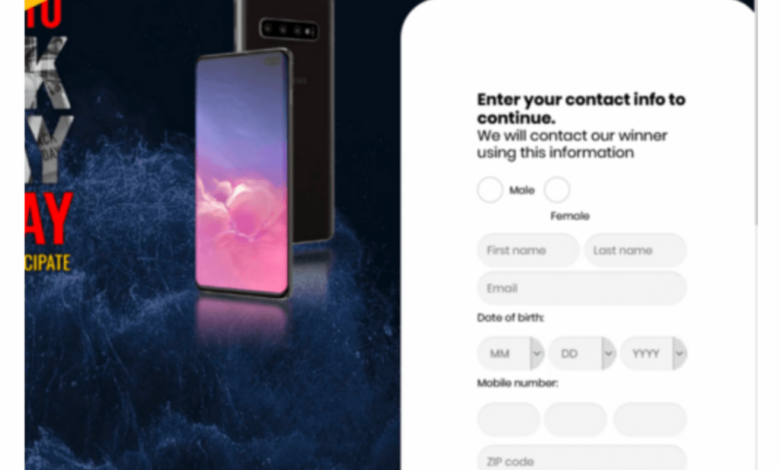
Just Beware of These 5 Black Friday or Thanksgiving Cyber Scams
Just beware of these 5 Black Friday or Thanksgiving cyber scams! The holiday shopping season is a goldmine for cybercriminals, and they’re getting increasingly sophisticated in their tactics. From convincing phishing emails to sneaky social media posts, the threats are real and widespread. This year, let’s be smarter than the scammers and protect ourselves from these common online traps.
We’ll dive into five major scams to watch out for, arming you with the knowledge to navigate the holiday sales safely and securely.
We’ll explore the sneaky ways scammers use phishing emails, fake websites, and social media to lure unsuspecting shoppers into handing over their personal information and hard-earned cash. We’ll also uncover the tricks behind fake gift card scams, malicious apps, and delivery scams. By the end, you’ll be equipped to spot these scams a mile away and enjoy a stress-free, secure shopping experience.
Phishing Emails and Fake Websites
Black Friday and Thanksgiving are prime times for cybercriminals. They leverage the excitement of holiday shopping to lure unsuspecting victims into phishing scams and fake websites. Understanding how these scams work is crucial to protecting yourself and your finances. This section will delve into the tactics used by scammers to create convincing phishing emails and fake websites, and how to identify them.
Phishing Email Examples
Let’s examine a realistic example of a phishing email designed to mimic a well-known retailer’s Black Friday sale. Imagine receiving an email with the following details:Subject: Your Exclusive Black Friday Deal from Amazon! (Limited Time Offer!)Sender: [email protected] (Notice the slightly off domain name)Body: Dear Valued Customer, Don’t miss out on Amazon’s incredible Black Friday sale! Click here to claim your exclusive discount: [link to fake website] This offer is valid for 24 hours only! Your personalized discount code is: BF2023-XYZ123.This email uses a convincing subject line and attempts to create a sense of urgency.
The sender address is similar to Amazon’s but subtly different. Crucially, the link leads to a fake website designed to steal personal information.
Comparison of Legitimate and Phishing Emails
The following table highlights key differences between legitimate and phishing emails:
| Feature | Legitimate Email | Phishing Email | Explanation of Difference |
|---|---|---|---|
| Sender Address | Official company email address (e.g., [email protected]) | Similar but slightly altered address (e.g., [email protected]) | Legitimate emails use verified company domains. Phishing emails often use similar but slightly different domains or free email services. |
| Subject Line | Clear and concise, often mentioning specific order details or promotions. | Generic and urgent, often using all caps or excessive exclamation points. | Legitimate emails avoid creating a sense of panic. Phishing emails use urgency to pressure recipients into quick action. |
| Links | Links directly to the official website (e.g., amazon.com) | Links to a fake website designed to mimic the official site. | Hover over links to see the actual URL before clicking. Phishing links often lead to suspicious domains. |
| Personalization | Often includes personalized details, such as your name and order number. | May include generic greetings or no personalized information. | Legitimate emails often use data they already have about you. Phishing emails may not. |
Fake Website Design and Detection
Scammers employ sophisticated techniques to create convincing fake websites. They often use readily available website builders and templates, mirroring the design and layout of real online stores. They might even steal images and product descriptions directly from the legitimate website.
Identifying Fake Websites
Several indicators can help you spot inconsistencies and identify fake websites:Website URLs: Carefully examine the website URL. Phishing websites often have slightly altered URLs, using similar but not identical domain names (e.g., amazon.com vs. amaz0n.com). Look for misspellings or unusual characters.Security Certificates: Check for a secure connection (HTTPS) indicated by a padlock icon in the browser address bar.
However, even this can be faked, so further inspection is needed.Website Design: Pay attention to inconsistencies in design, grammar, and spelling. Legitimate websites maintain a consistent brand image and professional presentation. Fake websites may have errors or inconsistencies.Overall Look and Feel: Trust your instincts. If something seems “off” about the website—the design is sloppy, the prices are too good to be true, or the website feels unprofessional—it’s best to err on the side of caution.
Social Media Scams: Just Beware Of These 5 Black Friday Or Thanksgiving Cyber Scams
Social media has become a prime hunting ground for scammers during Black Friday and Thanksgiving. The ease of reaching a wide audience and the inherent trust users often place in their social media connections makes these platforms particularly vulnerable to exploitation. Scammers leverage the excitement surrounding holiday sales to lure unsuspecting shoppers into their traps.These scams often mimic legitimate businesses or influencers, creating a veneer of authenticity to deceive their victims.
They employ various techniques, from cleverly worded posts to sophisticated phishing links, to trick users into divulging sensitive personal information or parting with their money for products or services that don’t exist.
Examples of Social Media Scams
Social media scams related to Black Friday deals often appear as incredibly tempting offers. For example, a Facebook post might advertise a “limited-time only” 90% discount on a popular electronic device, accompanied by a compelling image and a link to a fake website. On Instagram, a seemingly legitimate influencer might promote a giveaway for a luxury item, requiring users to follow several accounts and tag friends in the comments.
Twitter might see a flurry of tweets promising exclusive Black Friday deals from a verified-looking account, but with a shortened, suspicious URL. These examples demonstrate the versatility and reach of these scams across different platforms.
Tactics Used by Social Media Scammers
Scammers utilize a range of manipulative tactics to achieve their goals. One common tactic is urgency. Posts often emphasize limited-time offers or limited quantities to pressure users into immediate action, preventing them from critically evaluating the deal. Another is social proof. Fake comments and likes create the illusion of legitimacy, making the scam appear more trustworthy.
Scammers also exploit trust in influencers and celebrities, using fake accounts or impersonating real accounts to promote their fraudulent deals. Finally, they use shortened URLs and deceptive landing pages to conceal the true nature of the website.
Verifying the Authenticity of Social Media Accounts
Before engaging with any social media account promoting Black Friday deals, it’s crucial to verify its authenticity. Check the account’s age and activity. A newly created account with limited engagement is a significant red flag. Look for a verified badge, though remember that verification doesn’t guarantee legitimacy. Inspect the account’s content for inconsistencies or grammatical errors.
Research the company or brand mentioned in the post. Does the deal align with their typical pricing and promotions? Compare the deal to those offered on the official company website. A substantial discrepancy should raise suspicion.
Red Flags in Social Media Posts Advertising Black Friday Deals
Several red flags should trigger caution. Suspicious links, particularly those shortened or leading to unfamiliar domains, are major warning signs. Unrealistic offers, such as discounts exceeding 80% or giveaways of high-value items with minimal effort, should be treated with extreme skepticism. A lack of verifiable contact information, such as a physical address or phone number, is another red flag.
Poor grammar and spelling mistakes in posts indicate a lack of professionalism and could signal a scam. An excessive emphasis on urgency or pressure tactics should also raise concern. Finally, be wary of requests for personal information beyond what’s necessary for a transaction.
Gift Card Scams

Black Friday and Thanksgiving are prime times for scammers, and gift cards are a favorite target. The allure of deeply discounted gift cards or the promise of free ones is incredibly tempting, making them a perfect bait for unsuspecting shoppers. These scams prey on our desire for bargains and the convenience of gift cards, leading to significant financial losses for many.Gift card scams typically involve fake or compromised gift cards offered at significantly reduced prices or even for free.
Scammers might promote these “deals” through various channels, exploiting the urgency and excitement of the holiday shopping season. They often create a sense of scarcity, claiming limited availability to pressure victims into making quick decisions without proper verification. The promise of a great deal masks the reality of a fraudulent transaction that leaves the victim with a worthless card and an empty wallet.
Methods of Distributing Fake Gift Cards
Scammers utilize various methods to distribute their fraudulent gift cards. These include deceptive emails promising incredible discounts on popular gift cards, social media advertisements featuring unbelievably low prices, and fake websites designed to mimic legitimate online retailers. These fake websites often have similar logos and designs to well-known brands, making them difficult to identify as fraudulent at first glance.
Another common tactic involves phishing emails that appear to be from reputable companies, containing links to fake websites or requesting gift card information under false pretenses.
Verifying Gift Card Authenticity
Before purchasing or using a gift card, particularly one obtained through an unusually cheap offer, it’s crucial to verify its authenticity. First, check the seller’s reputation. If purchasing from an individual online, look for reviews and feedback from other buyers. For online retailers, verify that the website is legitimate and secure (look for “https” in the URL and a padlock icon).
Next, examine the gift card itself. Look for any signs of tampering or damage, such as scratches, unusual printing, or inconsistencies in the design. Finally, contact the gift card issuer directly. Use the contact information found on the issuer’s official website, not the information provided by the seller. Ask them to verify the card’s balance and authenticity.
If the issuer cannot verify the card, it is likely fraudulent.
Responding to a Suspected Gift Card Scam
If you suspect you’ve been scammed through a fraudulent gift card purchase, act quickly. First, immediately contact your bank or credit card company to report the fraudulent transaction and dispute the charge. Next, report the scam to the Federal Trade Commission (FTC) and your local law enforcement agency. Gather all relevant information, such as the seller’s details, transaction records, and any communication you had with the scammer.
This information will be crucial for investigations. Finally, change your passwords for any online accounts that may have been compromised, and be extra cautious about future online transactions. Remember, prevention is key. Be wary of deals that seem too good to be true, and always verify the authenticity of gift cards before using them.
Fake Apps and Mobile Malware

Black Friday and Thanksgiving deals are incredibly tempting, but downloading apps promising unbelievable discounts can lead to serious trouble. Many malicious actors create fake shopping apps designed to steal your personal information, install malware on your phone, or even empty your bank account. It’s crucial to be vigilant and understand the risks before clicking that download button.These fake apps often mimic legitimate shopping sites, using similar logos and names to trick unsuspecting users.
Once downloaded, they can unleash a variety of harmful malware, ranging from spyware that tracks your online activity to ransomware that locks your phone until you pay a ransom. In some cases, they can even silently subscribe you to expensive premium services without your knowledge.
Types of Malware Found in Fake Shopping Apps
Fake shopping apps can harbor various types of malware, each with its own damaging capabilities. For example, spyware can secretly record your keystrokes, capturing passwords and credit card details. Adware floods your phone with intrusive and unwanted advertisements, slowing down your device and potentially exposing you to further threats. Ransomware, as mentioned, can encrypt your files and demand payment for their release.
Finally, Trojans can act as a backdoor, allowing hackers to remotely control your device and steal your data. The consequences of these infections can range from financial loss and identity theft to significant disruption of your daily life.
Identifying Legitimate Shopping Apps
Determining if a shopping app is legitimate requires careful examination. Begin by checking the app store’s developer information. Legitimate apps usually have detailed developer information, including contact details and a history of other apps they’ve published. Look for a large number of positive reviews, but also examine the reviews themselves for any red flags – an unusually high number of negative reviews or reviews complaining about malware or scams should raise concerns.
Just beware of those sneaky Black Friday and Thanksgiving cyber scams – they’re everywhere! I’m actually trying to focus on more productive things, like learning about the future of app development, which is why I’ve been reading up on domino app dev, the low-code and pro-code future. It’s a fascinating field, but let’s not forget those holiday hackers – stay vigilant out there!
Finally, pay close attention to the permissions requested by the app. A legitimate shopping app shouldn’t need access to your contacts, microphone, or location unless absolutely necessary for specific features (like location-based services).
Comparison of Legitimate vs. Malicious Shopping Apps
| Feature | Legitimate Shopping App | Malicious Shopping App |
|---|---|---|
| Permissions Requested | Limited to necessary functions like network access, storage for downloads, and potentially location for delivery. | Requests extensive permissions, including access to contacts, microphone, camera, location, and potentially even SMS messages. |
| Reviews | Numerous positive reviews with detailed descriptions of positive experiences. Negative reviews are addressed and responded to by the developer. | Few reviews, many negative reviews mentioning malware, scams, or unexpected charges. Developer may not respond to negative feedback. |
| Developer Information | Clear and detailed developer information, including contact information, website, and a history of other apps. | Limited or vague developer information. May use a generic name or lack a website. |
Delivery and Shipping Scams
Black Friday and Thanksgiving deals are tempting, but scammers are ready to capitalize on the holiday shopping rush. One particularly prevalent tactic involves manipulating delivery and shipping information to trick unsuspecting shoppers into handing over their money or personal details. These scams can range from subtle delays to outright fraudulent tracking numbers, all designed to exploit the anxiety associated with waiting for eagerly anticipated purchases.Delivery and shipping scams leverage the consumer’s desire for timely delivery and their trust in legitimate delivery services.
Scammers employ various methods to create a sense of urgency and pressure, hoping to bypass critical thinking and prompt impulsive actions. This often involves creating fake tracking numbers, impersonating delivery companies, or sending deceptive emails and text messages that mimic legitimate communications. The goal is always the same: to either steal money directly or to gather sensitive information that can be used for identity theft or further fraudulent activities.
Fake Tracking Numbers and Delivery Delays
Scammers often generate fake tracking numbers that appear legitimate, but lead to nonexistent packages or outdated information. They might send a text message or email claiming your package is delayed, requiring you to click a link to update your shipping information or pay additional fees. This link frequently leads to a phishing website designed to steal your personal data.
Alternatively, they may simply never deliver the product, leaving you with the impression that it’s simply taking a long time, only to realize much later that you’ve been scammed. For example, a scammer might send an email stating, “Your package (tracking number: 1Z999AA10123456785) has been delayed due to unforeseen circumstances. Please update your shipping address here: [malicious link]”.
The tracking number itself might be valid, but associated with a different package or entirely fabricated.
Impersonating Legitimate Delivery Services
Scammers frequently impersonate well-known delivery services like FedEx, UPS, or USPS. They might use email addresses or text message numbers that closely resemble those of legitimate companies, hoping you’ll overlook subtle differences. Their messages often contain urgent requests for additional information, payment, or confirmation of delivery, all under the guise of resolving a supposed delivery issue. For instance, a fraudulent text message might read: “Your UPS package is delayed due to an address issue.
Please confirm your address here: [link to phishing site]”. The message’s formatting and language might closely mimic an official UPS message, making it difficult to immediately identify the scam.
Examples of Scam Emails and Text Messages, Just beware of these 5 black friday or thanksgiving cyber scams
“Dear Customer, Your order #12345 is delayed due to an undeliverable address. Please update your address immediately at [malicious link] to avoid further delays.” (Note: This email lacks a company logo, uses generic language, and contains a suspicious link.)
Text Message
“Your package from Amazon is awaiting delivery. Please confirm your address and payment at [shortened URL] to avoid return to sender.” (Note: The message is vague and employs a shortened URL, hiding the actual destination.)
“Urgent: Your FedEx package (Tracking #1234567890) requires additional payment of $
15. Please click here to pay
[link to a fake payment portal]” (Note: Legitimate delivery services rarely request additional payment via email or text message, particularly not through links.)
Steps to Take if You Suspect a Delivery Scam
Before taking any action, carefully examine any email or text message you receive concerning your package delivery. Be wary of urgent requests, suspicious links, and requests for personal information.
- Do not click on any links in suspicious emails or text messages.
- Contact the actual delivery service directly through their official website or phone number to verify the information.
- Never provide your personal information or payment details in response to unsolicited emails or text messages.
- Report the scam to the delivery service and to the appropriate authorities, such as the Federal Trade Commission (FTC).
- Monitor your bank accounts and credit reports for any unauthorized activity.
Wrap-Up
So, this Black Friday and Thanksgiving, remember – vigilance is your best weapon! Don’t let the excitement of amazing deals blind you to potential threats. By staying informed about common scams and following simple safety precautions, you can protect yourself from becoming a victim. Happy, and safe, shopping!
Commonly Asked Questions
What should I do if I think I’ve clicked a phishing link?
Immediately change your passwords for all affected accounts. Monitor your bank and credit card statements for unauthorized activity. Report the phishing email to the appropriate authorities and the company it’s impersonating.
Are all Black Friday deals on social media legitimate?
No! Always verify the authenticity of the account and the deal before clicking any links or providing information. Look for verified accounts and check for reviews from other users.
How can I tell if a gift card is fake?
Check the gift card’s packaging for any signs of tampering. Verify the card’s authenticity with the retailer directly using the information on the card.
What permissions should a legitimate shopping app request?
Legitimate apps generally only request access to features directly related to their function (like location for delivery). Excessive permissions are a red flag.





